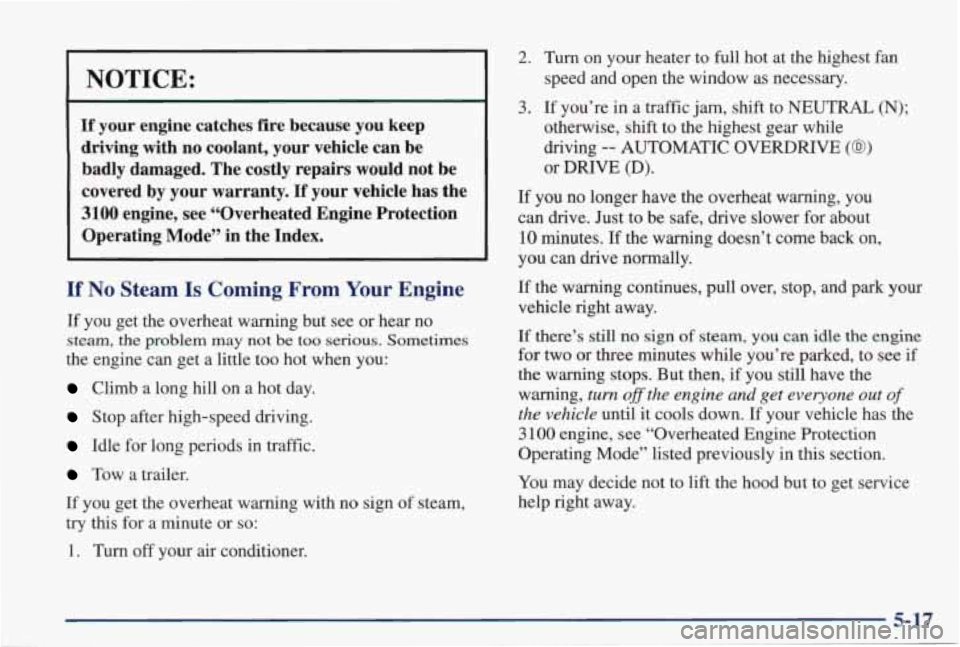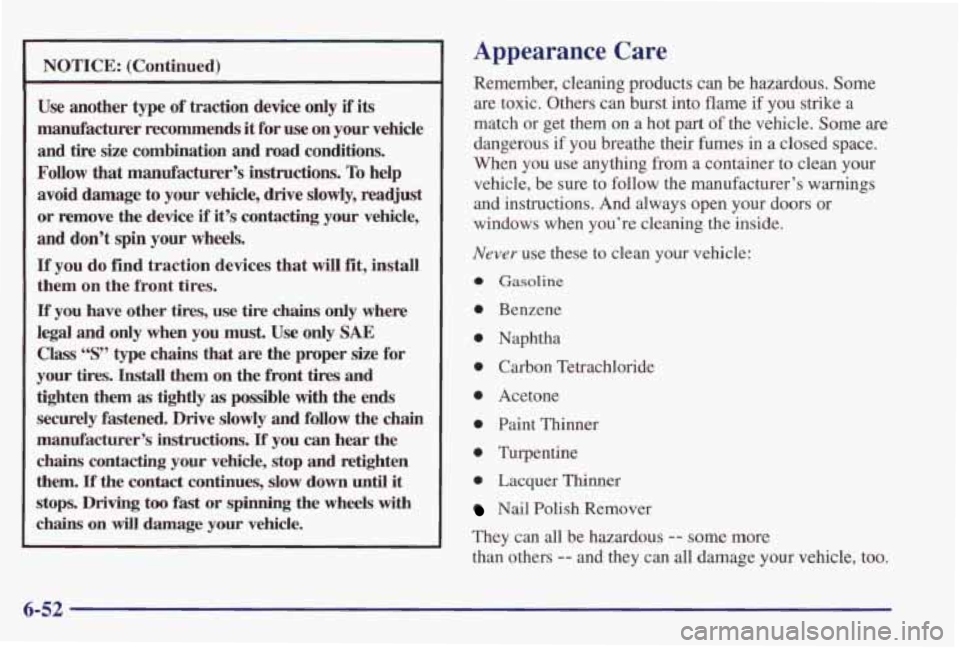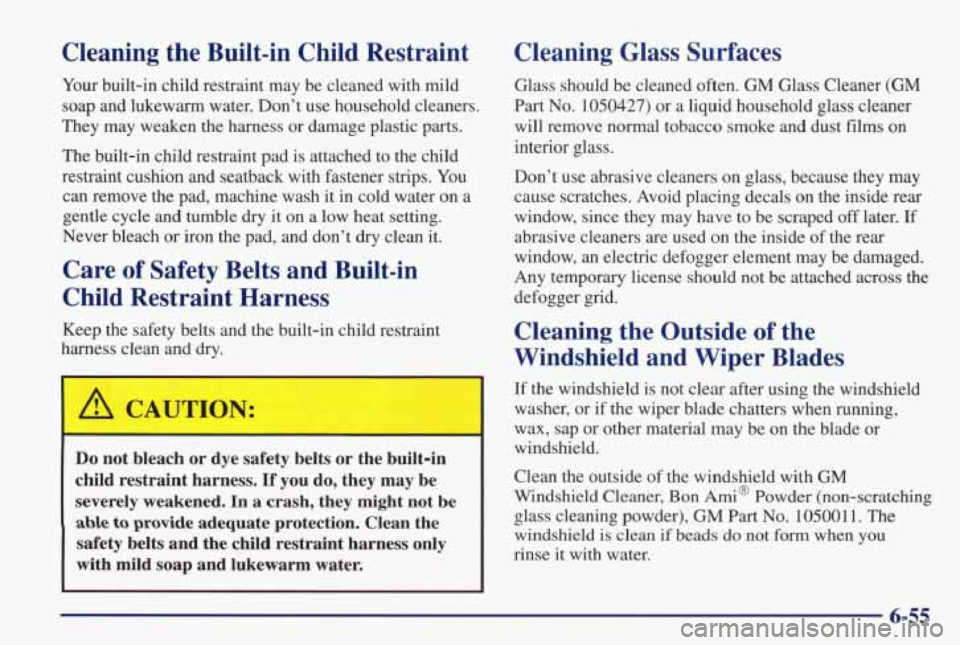1998 PONTIAC GRAND PRIX window
[x] Cancel search: windowPage 223 of 402

Tie a red cloth to your vehicle to alert police that
you’ve been stopped by the snow.
0 Put on extra clothing or wrap a blanket around you.
If you have no blankets or extra clothing, make body
insulators
from newspapers, burlap bags, rags, floor
mats
-- anything you can wrap around yourself or
tuck under your clothing
to keep warm.
Snow can trap exhaust gases under your vehicle.
This can cause deadly
CO (carbon monoxide) gas
to get inside.
CO could overcome you and kill
you. You can’t see it or smell it, so you might not
know it
is in your vehicle. Clear away snow from
around the base of your vehicle, especially any
that
is blocking your exhaust pipe. And check
around again from time to time to be sure snow
doesn’t collect there.
Open a window just a little
on the side of the
vehicle that’s away from
the wind. This will help
keep
CO out.
You can run the engine to keep warm, but be careful.
4-30
Page 224 of 402

Run your engine only as long as you must. This saves
fuel. When you run the engine, make it
go a little faster
than just idle. That is, push the accelerator slightly. This
uses less fuel for the heat that you get and it keeps the
battery charged. You will need
a well-charged battery to
restart the vehicle, and possibly for signaling later on
with your headlamps. Let the heater
run for a while.
Then, shut the engine off and close the window almost
all the way to preserve the heat. Start the engine again
and repeat this only when you feel really uncomfortable
from the cold. But do it as little as possible. Preserve the
fuel as long as you can.
To help keep warm, you can get
out
of the vehicle and do some fairly vigorous exercises
every half hour or
so until help comes.
Loading Your Vehicle
TIRE - LOADING INFORMATION A
OCCUPANTS
MAX. LOADING @ GVWR SAME
1 1
r
'U
IT, ADD 28KPA (4LBS)
Manual for tire pressure needed at
himlH(100 mph) or higher speeds, where legal, kr nrlrlitinnal tira inlnrmo+inn
Two labels on your vehicle show how much weight it
may properly carry. The Tire-Loading Information label
is on the inside of the trunk lid. The label tells you the
proper size, speed rating and recommended inflation pressures for the tires on your vehicle. It also gives you
important information about the number
of people that
can be in your vehicle and the total weight you can
carry. This weight is called the vehicle capacity weight
and includes the weight
of all occupants, cargo and all
nonfactory-installed options.
4-3 1
Page 252 of 402

NOTICE:
If your engine catches fire because you keep
driving with no coolant, your vehicle can be
badly damaged. The costly repairs would not be
covered by your warranty.
If your vehicle has the
3100 engine, see “Overheated Engine Protection
Operating Mode” in the Index.
If No Steam Is Coming From Your Engine
If you get the overheat warning but see or hear no
steam, the problem may not be too serious. Sometimes
the engine can get a little too hot when you:
Climb a long hill on a hot day.
Stop after high-speed driving.
Idle for long periods in traffic.
Tow a trailer.
If you get the overheat warning with no sign of steam,
try this for a minute or so:
1. Turn off your air conditioner.
2. Turn on your heater to full hot at the highest fan
speed and open the window as necessary.
3. If you’re in a traffic jam, shift to NEUTRAL (N);
otherwise, shift to the highest gear while
driving
-- AUTOMATIC OVERDRIVE (03)
or DRIVE (D).
If you no longer have the overheat warning, you
can
drive. Just to be safe, drive slower for about
10 minutes. If the warning doesn’t come back on,
you can
drive normally.
If the warning continues, pull over, stop, and park
your
vehicle right away.
If there’s still no sign of steam, you can idle the engine
for two or three minutes while you’re parked, to see if
the warning stops. But then, if you still have the
warning,
turn off the engine and get everyone out of
the vehicle until it cools down. If your vehicle has the
3 100 engine, see “Overheated Engine Protection
Operating Mode” listed previously in this section.
You may decide not to lift the hood but to get service
help right away.
5-17
Page 327 of 402

.~
NOTICE: (Continued)
Use another type of traction device only if its
manufacturer recommends it for
use on your vehicle
and tire
size combination and road conditions.
Follow that manufacturer’s
instructions. To help
avoid damage to your vehicle, drive slowly, readjust
or remove the device if it’s contacting your vehicle,
and don’t spin
your wheels.
If you do find traction devices that will fit, install
them on the front tires.
If you have other tires, use tire chains only where
legal and only when you
must. Use only SAE
Class “S” type chains that are the proper size for
your
tires. Install them on the front tires and
tighten them
as tightly as possible with the ends
securely fastened. Drive slowly and follow the chain
manufacturer’s instructions.
If you can hear the
chains contacting your vehicle, stop and retighten
them.
If the contact continues, slow down until it
stops. Driving too fast or spinning the wheels with
chains on will damage your vehicle.
Appearance Care
Remember, cleaning products can be hazardous. Some
are toxic. Others can burst into flame if you strike a
match or get them on a hot
part of the vehicle. Some are
dangerous if you breathe their fumes in a closed space.
When you use anything from
a container to clean your
vehicle, be sure to follow the manufacturer’s warnings
and instructions. And always open your doors or
windows when you’re cleaning the inside.
Never use these to clean your vehicle:
a Gasoline
0 Benzene
0 Naphtha
0 Carbon Tetrachloride
0 Acetone
0 Paint Thinner
0 Turpentine
0 Lacquer Thinner
Nail Polish Remover
They can all be hazardous
-- some more
than others -- and they can all damage your vehicle, too.
6-52
Page 330 of 402

Cleaning the Built-in Child Restraint
Your built-in child restraint may be cleaned with mild
soap and lukewarm water. Don’t use household cleaners.
They may weaken the harness or damage plastic parts.
The built-in child restraint pad is attached to the child
restraint cushion and seatback with fastener strips. You
can remove the pad, machine wash it in cold water on a
gentle cycle and tumble
dry it on a low heat setting.
Never bleach or iron the pad, and don’t
dry clean it.
Care of Safety Belts and Built-in
Child Restraint Harness
Keep the safety belts and the built-in child restraint
harness clean and
dry.
I A CAUTION:
Do not bleach or dye safety belts or the built-in
child restraint harness. If you do, they may be
severely weakened. In a crash, they might not be
able to provide adequate protection. Clean the
safety belts
and the child restraint harness only
with mild soap and lukewarm water.
Cleaning Glass Surfaces
Glass should be cleaned often. GM Glass Cleaner (GM
Part No. 1050427) or a liquid household glass cleaner
will remove normal tobacco smoke and dust films on
interior glass.
Don’t use abrasive cleaners on glass, because they
may
cause scratches. Avoid placing decals on the inside rear
window, since they may have to be scraped
off later. If
abrasive cleaners are used on the inside of the rear
window, an electric defogger element may be damaged.
Any temporary license should not be attached across the
defogger grid.
Cleaning the Outside of the
Windshield and Wiper Blades
If the windshield is not clear after using the windshield
washer, or if the wiper blade chatters when running,
wax, sap or other material may be on the blade or
windshield.
Clean the outside of the windshield with GM
Windshield Cleaner, Bon
Ami@ Powder (non-scratching
glass cleaning powder), GM
Part No. 105001 1. The
windshield is clean if beads
do not form when you
rinse it with water.
Page 338 of 402

Windshield Wipers
The windshield wiper motor is protected by a circuit
breaker and a fuse.
If the motor overheats due to heavy
snow, etc., the wiper will stop until the motor cools.
If
the overload is caused by some electrical problem, have
it fixed.
Power Windows and Other Power Options
Circuit breakers in the fuse panel protect the power
windows and other power accessories. When the current
load is too heavy, the circuit breaker opens and closes,
protecting the circuit until the problem is fixed.
Instrument Panel Fuse Block
Some fuses are in a fuse block located inside of the glove
box behind a
small bin, on the right side. To open, pull on
the plastic strap
and pull the cover out. The fuse block is
inside.
On the back edge of this cover is a fuse puller and
a fuse usage chart. To use the fuse puller, place the wide
end
of the fuse puller over the plastic end of the fuse.
Squeeze the ends over the fuse and pull it out.
To reinstall the bin, position the lower end and turn
the top into position. Press on the sides until
it snaps
into place.
6-63
Page 339 of 402

FUSE USAGE CHART I See Underhood Electrical
Center For Spare Fuses I I I I
CIRCUIT BREAKERS
I HEADLAMP I
I I MAUPGM
STR WHL STR WHL
CTRL
I
I I PWR LOCK I I
RAP HAZARD ~
GIG LTR
I/P - IGN
CRUISE
ECM STOP LAMP
INT LAMP
ABS
PWR DROP MALL
WIPER
SUNROOF
CD CHG
AUWCNSL HVAC
HI PWR MIR
R DEFOG
HSEATILUM
RADIO
SIR TURN
BTSl
HVAC CTRL DlCRlVAC
I I I I CANISTER DRL VENT
rinted in USA.
For More Information, See Owner’s Manual 10401979)
Description
Circuit
Breaker
HEADLAMP
Headlamps
SEAT Power Seat, Power Lumbar
PWR WDO Power Windows
Fuse Description
MALL PGM Mall Module -- Program
MALL Mall Module
Fuse
WIPER
STR WHL
STR WHL
CTRL
SUNROOF
RADIO
PWR LOCK
HSEATLUM
R DEFOG
RAP
HAZARD
PWR MIR HVAC
HI
CIG LTR
INT LAMP STOP LAMP
Description
Wipers
Steering Wheel Illumination
Steering Wheel Control
Sunroof
Radio, Antenna
Mall Module
-- Power Locks
Heated Seats, Power Lumbar
Rear Defog
Retained Accessory Power, Mall Module
Hazard Flashers
Power Mirrors
HVAC Blower -- Hi
Cigarette Lighter,
ALDL, Floor
Console Auxiliary Outlet
Mall Module
-- Interior lamps
S toplamp
6-64
Page 384 of 402

Glass .............. .................... 6-55
Inside of
Your Vehicle ......................... 6-53
Instrument Panel
............................. 6-54
Interior Plastic Components
..................... 6-54
Leather
..................................... 6-54
Outside of
Your Vehicle ........................ 6-56
Special Problems
............................. 6-53
Tires
............ ....... ........ 6-58
Wheels
........................... ...... 6-57
Windshield and Wiper Blades
................... 6-55
Climate Control System
........................... 3-2
Clock, Setting the
............................... 3-10
Column Shift
.................................. 2-28
Comfort Controls
.... ..................... 3-1
Compact Disc Care
....... .................. 3-32
Compact Disc Player
....................... 3-19, 3-22
Compact Disc Player Care
........................ 3-32
Compact Disc Player Errors
............. 3-21,3-23, 3-25
Compact Spare Tire ............................. 5-37
ConsoleShift
.................................. 2-29
Content Theft-Deterrent
.................... 2- 14, 2-50
Content Theft-Deterrent, Arming and Disarming
...... 2-51
Control of a Vehicle
.............................. 4-6
Convenience Net
............................... 2-57
Convex Outside Mirror
.......................... 2-53
Coolant
....................................... 6-26
BleedValves
................................. 5-24
Heater, Engine
............................. 2-20
Stains
...................................... 6-53
Vinyl
.......................... ........ 6-54 Recovery Tank
........ .... 5-20
To Use the Engine Heater .................... 2-20
Cooling System
................................ 5-18
Courtesy Lamps
................................ 2-42
Courtesy Transportation
........................... 8-8
Cruise Control
................................. 2-37
Customer Assistance for Text Telephone Users
......... 8-5
Customer Assistance Information ................... 8-1
Customer Satisfaction Procedure
.................... 8-3
Damage. Finish
... ...... 6-58
Damage. Sheet Metal
. . ...... ...... 6-58
Daytime Running Lamps
.............. ...... 2-41
Dead Battery
..................... .......... 5-3
Defects. Reporting Safety
........................ 8-10
Defensive Driving
............................... 4-2
Defogger. Rear Window .......................... 3-9
Defogging and Defrosting ..................... 3-4. 3-8
Defrosting. Defogging
.... ........ 3-4. 3.8
Delayed Illumination ............ .... 2.43. 2.47
Dimensions. Vehicle
............... ...... 6-69
Disarming with the Remote Keyless Entry Transmitter
................. .... 2-15
Disarming with
Your Key ...................... 2-15
Dolby@ B Noise Reduction
.................. 3.14. 3.18
DoorLocks
..................................... 2. 4
Driver Information Center ........................ 2-76
Driver Position
................................. 1-14
Driver’s Temperature Knob. Automatic
and
Auxiliary Temp Control ......................... 3-5
9-3